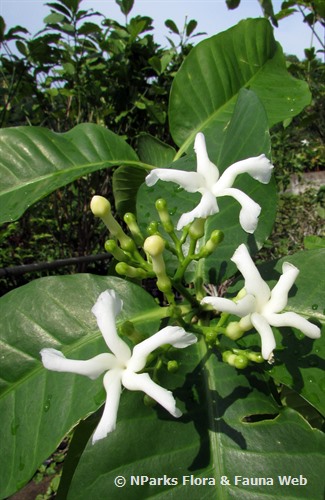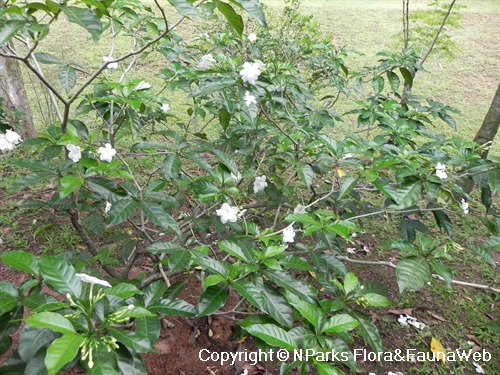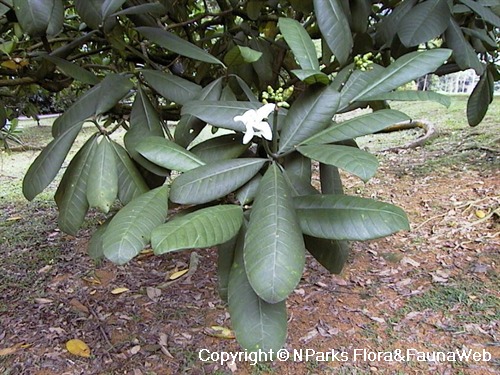.jpg)
Back
Tabernaemontana pauciflora Blume
| Family Name: | Apocynaceae |
| Synonyms: | Ervatamia blumeana Markgr., Ervatamia blumeana var. macropetala Bakh.fil., Ervatamia calycina (Wall.) Lace, Tabernaemontana calycina Wall., Tabernaemontana dinhensis Pit., Tabernaemontana harmandiana Pierre ex Pit. |
| Common Name: | Lada-lada |
Tabernaemontana pauciflora is a shrub or a tree that grows up to 6 m tall. It has white fragrant tubular flowers that attract moths for pollination. Its fruit are ellipsoid or oblong-shaped, bearing 2-16 seeds covered in red flesh. This species grows well under full sun on well-drained soil with moderate watering.
Name
Classifications and Characteristics
| Plant Division | Angiosperms (Flowering Seed Plants) (Dicotyledon) |
|---|---|
| Plant Growth Form | Shrub, Tree |
| Lifespan (in Singapore) | Perennial |
| Mode of Nutrition | Autotrophic |
| Maximum Height | 6 m |
Biogeography
| Native Distribution | Cambodia, Vietnam, Thailand, Peninsular Malaysia, Singapore, Borneo, Sumatra, Java. |
|---|---|
| Native Habitat | Terrestrial |
| Preferred Climate Zone | Tropical |
| Local Conservation Status | Native to Singapore (Endangered (EN)) |
Description and Ethnobotany
| Growth Form | A shrub to a small tree that grows up to 6 m tall. |
|---|---|
| Foliage | The leaves are elliptic, measuring 3-26 cm long and 0.6-10 cm wide, papery texture, and oppositely arranged along the stem. The leaf blad has acuminate or caudate tip and cuneate base. |
| Stems | The stem can be up to 10 cm in diameter. The twigs are smooth, with few lenticels. It has pale yellow sapwood (the outer layer of wood). |
| Flowers | The white flowers are fragrant, arranged in a cluster of 3-15 flowers, with each flower measuring 2 - 16.5 cm long, and has smooth surface. |
| Fruit | The fruit is orange, ellipsoidal or oblong-shaped, and has vertical ridges. The fruit contains 2-16 ellipsoidal seeds of up to 10 mm long, covered in red flesh. |
| Habitat | It is found growing as understorey plant in primary and secondary forests. |
| Etymology | The genus epithet Tabernaemontana is named after Jakob Theodor von Bergzaben (1520 - 1590) (Latinised surname, Tabernaemontanus meaning "tavern in the mountain"), who was a German herbalist. The species epithet pauciflora means few-flowered. |
Landscaping Features
| Desirable Plant Features | Ornamental Flowers, Ornamental Fruits, Fragrant (Flowers) |
|---|---|
| Landscape Uses | General, Parks & Gardens |
Fauna, Pollination and Dispersal
| Fauna Pollination Dispersal Associated Fauna | Moth Food Plant (Flower Pollen) |
|---|---|
| Pollination Method(s) | Biotic (Fauna) (Insects (Butterfly, Moth)) |
Plant Care and Propagation
| Light Preference | Full Sun |
|---|---|
| Water Preference | Moderate Water |
| Plant Growth Rate | Moderate |
| Rootzone Tolerance | Well-Drained Soils |
| Propagation Method | Seed |
Foliar
| Foliage Retention | Evergreen |
|---|---|
| Mature Foliage Colour(s) | Green |
| Mature Foliage Texture(s) | Papery |
| Prominent Young Flush Colour(s) | Green |
| Young Flush Texture(s) | Papery |
| Foliar Type | Simple / Unifoliate |
| Foliar Arrangement Along Stem | Opposite |
| Foliar Attachment to Stem | Petiolate |
| Foliar Shape(s) | Non-Palm Foliage (Elliptical) |
| Foliar Venation | Pinnate / Net |
| Foliar Margin | Entire |
| Foliar Apex - Tip | Acuminate, Caudate |
| Foliar Base | Cuneate |
Non - Foliar and Storage
| Bark Colour(s) | Pale grey to grey brown, smooth surface. The inner bark is pale yellow. It has pale yellow sapwood. |
|---|
Floral (Angiosperm)
| Flower & Plant Sexuality | Bisexual Flowers |
| Flower Colour(s) | White |
|---|---|
| Flower Texture(s) | Smooth |
| Flower Grouping | Cluster / Inflorescence |
| Flower Symmetry | Radial |
| Individual Flower Shape | Tubular |
| Flower Size - Remarks | Flower tube is 11-23 mm long, petals are 7-14 x 3-9 mm long. |
| Flowering Habit | Polycarpic |
| Inflorescence Size | 16.5 cm |
Fruit, Seed and Spore
| Mature Fruit Colour(s) | Orange |
|---|---|
| Seed Quantity Per Fruit | Several (11-20) |
References
| References | <1> Middleton, D.J. & Rodda, M. (2019). Apocynaceae. Flora of Singapore, Vol.13:421-630. |
|---|
Image Repository
Others
| Master ID | 34140 |
|---|---|
| Species ID | 8553 |
| Flora Disclaimer | The information in this website has been compiled from reliable sources, such as reference works on medicinal plants. It is not a substitute for medical advice or treatment and NParks does not purport to provide any medical advice. Readers should always consult his/her physician before using or consuming a plant for medicinal purposes. |

.jpg)



